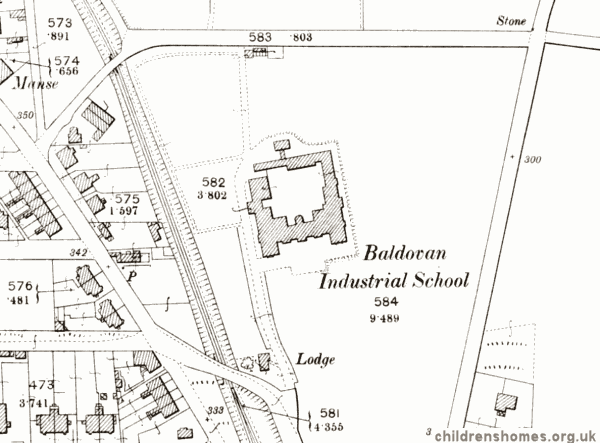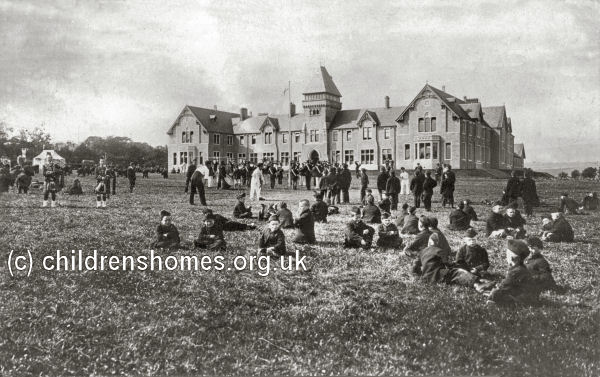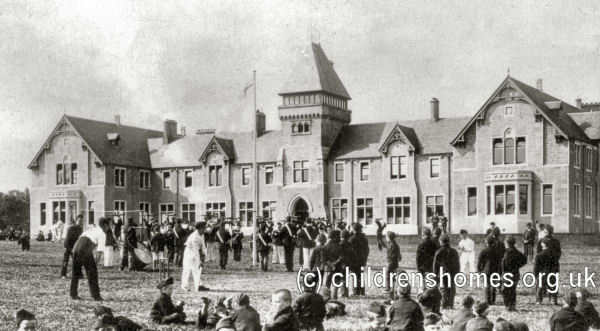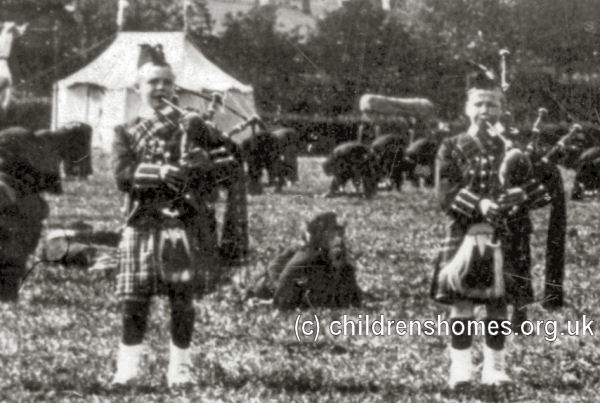Baldovan Industrial School for Boys / Balgowan School, Dundee, Angus (Forfarshire), Scotland
The Dundee Industrial School for Boys began life as part of the mixed establishment founded in Dundee in 1846. By the 1870s, the school's confined site on Ward Road led to plans to relocate the boys to new out-of-town premises on a thirteen-acre site on Strathmartine Road, Baldovan, several miles to the north of Dundee. The new institution was formally certified to operate as an Industrial School on 8 May 1878. It provided accommodation for 200 boys aged from 8 to 16 years at their date of admission.
The boys from Ward Road were removed to their new premises on 31 May, accompanied their superintendent, Captain Penton Thompson, who was continuing in the role at Baldovan. A tragedy was narrowly averted the following day when a serious gas explosion took place in the dining-hall. It happened when workmen carrying a light were trying to locate a gas leak. The men were very slightly injured but substantial damage occurred to the ceiling of the hall.
The school site is shown on the 1900 map below.

Dundee Industrial School for Boys site, Baldovan, Dundee, c.1900.

Dundee Industrial School for Boys from the south-east, Baldovan, early 1900s. © Peter Higginbotham

Dundee Industrial School for Boys (detail), Baldovan, early 1900s. © Peter Higginbotham

Dundee Industrial School for Boys (detail), Baldovan, early 1900s. © Peter Higginbotham

Dundee Industrial School for Boys (detail), Baldovan, early 1900s. © Peter Higginbotham
The transfer from the town to the countryside appears to have caused much unrest among the boys, with around 100 cases of absconding during the first three months following the move.
In 1879, Captain Thompson was replaced by Mr W.W. Dickson. Other staff now included a teacher, Mr Peter Langlands; two assistants, agent, drill-master, cook, housemaid, tailor, shoemaker, gardener and occasional bandmaster. Thirteen boys were occupied as shoemakers, producing work the girls' school as well as for the boys own use. Twenty-four boys worked as tailors. Sack-sewing and paper-bag making were also carried on. A class of juniors knitted stockings and neckties, mended and darned under female superintendence. Others helped in the house, kitchen and laundry. A growing number of boys worked at cultivating the schools' large garden. The school had its own band.
A novel feature of the school was the arrangement for delivering the dinners into the dining hall on a wagon running on a tramway from the kitchen.
In 1880, a Working Boys' Home was established as an Auxiliary Home at West bell Street, Dundee.
An inspection in 1896 described the school as an institutional building, but of an attractive kind, bright and cheerful, both outside and in. A feature of thee interior was the decoration of the walls done by the boys themselves. There was a good playfield in front of the school, where cricket and football were played twice a week. The remainder of the grounds were laid out as a vegetable and flower garden with one or two small plots in crops and roots. In the classroom, composition, recitation, geography, mental arithmetic and grammar were all rated 'very fair'. Drawing was being taught to about 40 selected boys, with Vere Forster's freehand series of animals etc. being sued as copies. The school had a good museum and botanical garden. The distribution of the boys to industrial occupations was: 40 tailoring, 20 shoemaking, 20 gardening, 12 cooking, 12 laundry (2 days a week), 38 knitters and darners, 36 sack-making, 6 painters, 6 joiners and 7 others on occasional duties. The knitters graduated to the tailor's and other departments after a preliminary apprenticeship there. There was a brass band with over 30 members. Military drill and other exercises were performed each day to the accompaniment of the band. A shed contained some gymnastic apparatus, with some instruction in its use given occasionally by the janitor. During the summer, two or three day-trips were made up the Tay to Sidlews(?), Perth etc. as well as to the grounds of friends of the school. Magic lantern entertainments, lectures, readings etc. were given about once in three weeks during the winter. The school library contained about 500 books, and presents of old magazines were constantly being received. Indoor games were also supplied for winter evenings.
Mr Dickson retired on 28 September 1906 and was succeeded by Mr James Winchester. Mr Dickson remained in touch with the school as the secretary of its committee.
In 1933, the establishment became an Approved School, one of the new institutions introduced by the Children and Young Persons (Scotland) Act to replace the existing system of Reformatories and Industrial Schools. Renamed Balgowan School, it accommodated up to 200 Junior Boys, aged from 6 to 14 years at their date of admission.
During the Second World War, the School was evacuated to Craig Lodge, Glenprosen, near Kirriemuir. In 1943, it was said to provide instruction in tailoring and gardening. The school band was still active. The headmaster was now Mr F. Gray.
The 1968 Social Work (Scotland) Act aimed to bring Approved Schools in Scotland under the control of local authority social work departments. As a result of a title in a list drawn up by the Scottish Education Department, Balgowan became referred to as a 'List D' school. Following a decline in numbers being placed at the school, it finally closed in 1983. The buildings no longer survive and the site is now covered by a modern housing estate.
Records
Note: many repositories impose a closure period of up to 100 years for records identifying individuals. Before travelling a long distance, always check that the records you want to consult will be available.
- Dundee City Archive & Record Centre, 21 City Square Dundee, DD1 3BY. Holdings: Minute books (1915-71), Reports (1863-1977), Maintenance accounts (1909-21), Report (1971), Miscellaneous papers (1968), Annual reports, 1966-1970.
- Friends of Dundee City Archives have compiled lists of inmates' details for Boys and Girls (1855-1916) and Girls (1877-1916).
Census
Bibliography
- Higginbotham, Peter Children's Homes: A History of Institutional Care for Britain's Young (2017, Pen & Sword)
- Mahood, Linda Policing Gender, Class and Family: Britain, 1850-1940 (1995, Univeristy of Alberta Press)
- Prahms, Wendy Newcastle Ragged and Industrial School (2006, The History Press)
Links
- None identified at present.
Except where indicated, this page () © Peter Higginbotham. Contents may not be reproduced without permission.


